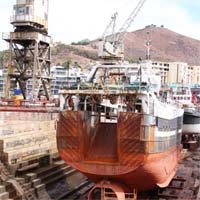Study Demonstrates Mesothelioma Risk from Shipbuilding

There’s more evidence of the dangers of shipbuilding in the early 20th century. A new study out of Italy found a “high incidence of mesothelioma” among men who worked as shipbuilders in the 1940’s, 50’s and 60’s in Monfalcone.
Mesothelioma is an aggressive cancer of internal membranes caused by exposure to asbestos. In order to track the incidence of the disease among Italian shipbuilders, a pair of researchers from Italy’s Center for the Study of Environmental Cancer examined the hiring records of the Monfalcone shipyard in 1942 and compared them with archived health records in the area’s hospitals decades later.
A total of 2,776 people were hired to work in the Monfalcone shipyards in 1942. According to the Pathological Anatomy Unit archives in the area’s two hospitals, between 1981 and 2005, 18 of the men hired in 1942 had been diagnosed with pleural mesothelioma. A third of the mesothelioma cases occurred in people who were only 14 or 15 years old at the time they were hired, even though there were only 557 in that age group. This finding appears to support other studies that have found that, the younger a person is at the time of asbestos exposure, the more likely they are to eventually develop mesothelioma.
Shipbuilders in the U.S. have faced a similar risk for mesothelioma. Shipyards were especially dangerous in the 40’s, 50’s and 60’s before the risks of asbestos were fully understood. At that time, asbestos, a strong, non-corrosive insulation and building material impervious to heat and flame, was used throughout ships, from the engine room to the kitchen. Men and women who helped build or repair such ships, as well as the sailors who spent months of their lives on them, faced a sharply increased risk for mesothelioma. In Hampton Roads, Virginia between 1982 and 2000 there were 632 cases of mesothelioma – seven times the national average.
Even with modern regulations in place to protect workers from mesothelioma, ships remain dangerous. Workers involved in dismantling decommissioned ships (called shipbreaking) may also be at risk for mesothelioma if they accidently breathe in or ingest asbestos fibers. Occupational Safety and Health Administration (OSHA) guidelines for safe shipbreaking in the presence of asbestos include wearing special negative-pressure respirators and limiting the time workers can spend in an asbestos-laden environment.
Unfortunately, the Italian study on shipbuilding and mesothelioma suggests that the problem is probably even larger than their data suggests. “While probably underestimated, the present data indicate a high incidence of mesothelioma among shipyard workers of Monfalcone,” they concluded.
Source:





